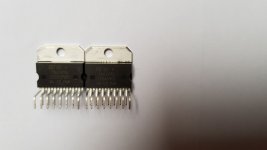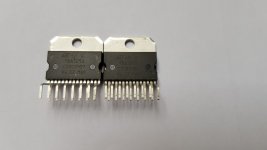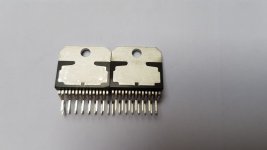You'll achieve a maximum output power of about 30 watts which should be enough with your speakers in your home environment.
Best regards!
Best regards!
Do you recommend using a speaker protect board with this amp?
If so, which one?
Thank you,
David.
Yes, I do. I use a speaker protection circuit that also has a turn on delay to prevent turn on thump and also has instant shut off when the mains is disconnected to prevent turn off thump. Chip amps are known to occasionally fail. When they do, full rail voltage is possibly released on the speaker. Many are available, but I recommend ones that use solid state relays rather than mechanical ones as they don’t arc or wear out and if properly designed, add no distortion.
Last edited:
@Kokanee
Are you using Lead Free Solder by any chance? Use the one with 3% Ag if you want to use lead free solder .I am personally horrible at soldering. My Granny recommended me to use Pine Rosin as Solder Flux , it works man. My solder now looks clean not dry like before. My experience is very little. Good soldering station is also very important.
Before getting pine rosin like this
https://www.amazon.com/1-Lb-Pine-Gu...eywords=Pine+Rosin&qid=1615048238&sr=8-3&th=1
I would like other experts to comment , whether it is fine to use Rosin now a days. Use a smoke extractor/absorber , Most people cut cost on it but important as smokes of rosin can harm your lungs, most solder wire comes with rosin core so flux will only be helpful for de soldering.
I use Metcal STTC-026 and STTC-106 tips for the really fine stuff. I also use Kester SN63PB37 rosin-core 0.020 solder for everything. The solder is really fine, but when I apply heat to the pad, I don't need much more to melt the solder. Also, I always heat the pad before applying the solder, even if only for a second. A second Metcal is set up with tweezers for SMD work.
I used to use flux before soldering, but now I find pre-cleaning the board with 99% isopropyl seems to do a better job. 70% isopropyl seems to leave a film, so I've stopped using it. I also post-clean with the 99%.
On the rework side, I have several different sizes of solder wick, including some very thin wick for getting in the holes and a Radio Shack hand-held solder-sucker. For heavy-duty rework, I also have a Blackjack Solderwerks BK8000. I use its solder sucker for the big jobs and save on copper.
Thanks for the info Ahtllc. 0.02" solder is 0.5 mm, only 0.1 mm smaller than what I use. I think I will buy a couple of finer tips and see what happens.
Yes, I do. I use a speaker protection circuit that also has a turn on delay to prevent turn on thump and also has instant shut off when the mains is disconnected to prevent turn off thump. Chip amps are known to occasionally fail. When they do, full rail voltage is possibly released on the speaker. Many are available, but I recommend ones that use solid state relays rather than mechanical ones as they don’t arc or wear out and if properly designed, add no distortion.
Which one are you using?
X is using these:
Ready-to-Run (RTR) SSR DC Speaker Protection and Delay GB
I have them installed in a few of my amplifiers and they work wonderful. The latest version has a few improvements over the first version that I’m using.
Ready-to-Run (RTR) SSR DC Speaker Protection and Delay GB
I have them installed in a few of my amplifiers and they work wonderful. The latest version has a few improvements over the first version that I’m using.
My TDA7293's, genuine or fakes?
Hi,
I managed to source a bunch of TDA7293's, see pics. Obvoiusly they're from two different batches. But are they genuine? What do you think?
Best regards!
Hi,
I managed to source a bunch of TDA7293's, see pics. Obvoiusly they're from two different batches. But are they genuine? What do you think?
Best regards!
Attachments
Do we generally use a standalone small transformer for the speaker protection relays are do you 'pinch' power from the amp itself?
Hi,
I managed to source a bunch of TDA7293's, see pics. Obvoiusly they're from two different batches. But are they genuine? What do you think?
Best regards!
Hi kay
As i learned from the LM1875 ebay thread that the only way to test if these chips are genuine is to short them and look if they are survive.🙄😉
chris
Thanks 😉!
What else could be in these cases that mimicks a TDA7293's functionalities more or less? A 7294 chip maybe. Anyway, this could be sorted out with the help of pin 11 which disables the connection between the low power and high power sections in a genuine 7293. Will test it.
Best regards!
What else could be in these cases that mimicks a TDA7293's functionalities more or less? A 7294 chip maybe. Anyway, this could be sorted out with the help of pin 11 which disables the connection between the low power and high power sections in a genuine 7293. Will test it.
Best regards!
Do we generally use a standalone small transformer for the speaker protection relays are do you 'pinch' power from the amp itself?
Generally we “pinch” or “steal” some power from the main power transformers. This is mainly for convenience. You could use a separate power source.
The SSR’s can be powered using a very simple half wave bridge with two 1N400x diodes and a 22uF cap connected to one of the main power trafo secondaries. The SSRs have on board voltage regulator to drop anything from 150v down to 15v. (I would not use anything above 80v rails though as the gen2 SSR itself is not meant for more than 300w amps). The small 22uF PSU had the advantage of collapsing within 100mS after the main power is cut off and shutting down the SSR to prevent speaker turn off thump.
Alternatively, you can power the SSR from the main DC rails of the Xmas amp and use the included bonus instant shutoff logic controller board. This board is also connected to the power trafo secondaries and generates the appropriate open collector logic to control the SSR to instantly shut off when it detects power being switched off.
Hope that answers your questions.
R20 is on the BOM sheet that I have.. Hmmm
Only change R15 (from 47.5K to 10K) if the DC offset is higher than 5-8mV DC. I have two builds and 47.5K worked fine on one build while i had to go to 10K on the other build.
The 10pF across R1 is from one gentleman's observation so whether it's necessary on everyone's build is still up in the air. I can't hear any difference with it on or off to tell you the truth ;>)
Pete
R20 was not on the Dec 6 BOM, but was added to the Jan 13 BOM. I also ordered off the Dec 6 BOM and am missing R20 and have to place another order. Fortunately I don't have to order just one resister because sometimes I have problems multiplying by 2. 😀
If R20 is the 100k on the input that is optional. It’s really there to keep the amp quiet in case you hot unplug the inputs while the amp is on. It keeps the input from picking up hum. Not critical if you use the amp with an input always connected.
If R20 is the 100k on the input that is optional. It’s really there to keep the amp quiet in case you hot unplug the inputs while the amp is on. It keeps the input from picking up hum. Not critical if you use the amp with an input always connected.
It doesn't sound like the 100k value is critical, than. Is there an acceptable range that it needs to be in? I might have extra resistors laying around.
I am building this amp for a friend who streams music from his computer to his TV and listens to it through the tv speakers, it sucks.
Anyway, to get hem set up so I can come over and enjoy some tunes when I visit, I would like to build him an integrated.
Any suggestions on a good pre I could use with this amp?
Anyway, to get hem set up so I can come over and enjoy some tunes when I visit, I would like to build him an integrated.
Any suggestions on a good pre I could use with this amp?
Any single ended Class A preamp will be.
I will recommend to build Pocket Class A amp by X as a preamp.
I will recommend to build Pocket Class A amp by X as a preamp.
When you say integrated amp, do you mean one with multiple input selectors and volume control?
I also like single ended class A for preamps. There are many to choose from and ones designed by Aksa (Hugh Dean) are my favorites. There are several projects on DIYA that use SE Class A - and many double as headphone amps.
Pass ACP+, Salas DCG3, and others. Look in the analog preamp or headphones forums for ideas.
https://www.diyaudio.com/forums/headphone-systems/
https://www.diyaudio.com/forums/analog-line-level/
Main thing is to keep it simple. All you need are 2 transistors, maybe 6 at most.
I also like single ended class A for preamps. There are many to choose from and ones designed by Aksa (Hugh Dean) are my favorites. There are several projects on DIYA that use SE Class A - and many double as headphone amps.
Pass ACP+, Salas DCG3, and others. Look in the analog preamp or headphones forums for ideas.
https://www.diyaudio.com/forums/headphone-systems/
https://www.diyaudio.com/forums/analog-line-level/
Main thing is to keep it simple. All you need are 2 transistors, maybe 6 at most.
- Home
- Amplifiers
- Chip Amps
- Xmas Amp - Dibya's TDA7293 by Jhofland


